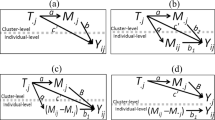Abstract
Although subgroup analyses, and moderator analyses more generally, in intervention research are fraught with analytic and conceptual challenges, they provide invaluable insights into the effectiveness of intervention strategies and the theoretical models upon which they rest. The papers in this Special Issue engage these challenges and offer investigators a set of strategies that will enhance how they think about, measure, test, and report evidence of moderated intervention effects. In this commentary, I echo the call for more thoughtful work on moderated intervention effects and, in particular, urge investigators to pursue opportunities to integrate questions regarding mediation as they work to specify how intervention strategies operate across populations, settings, and behavioral domains.

Similar content being viewed by others
References
Almirall, D., McCaffrey, D. F., Ramchand, R., & Murphy, S. A. (2012). Subgroups analysis when treatment and moderators are time-varying. Prevention Science.
Baron, R. M., & Kenny, D. A. (1986). The moderator-mediator variable distinction in social psychological research: Conceptual, strategic, and statistical considerations. Journal of Personality and Social Psychology, 51, 1173–1182.
Bloom, H. S., & Michalopoulos, C. (2012). When is the story in the subgroups? Strategies for interpreting and reporting intervention effects for subgroups. Prevention Science.
Borenstein, M., & Higgins, J. P. T., (2012). Meta-analysis and subgroups. Prevention Science.
Brown, C. H. et al. (2012). Methods for synthesizing findings on moderation effects across multiple randomized trials. Prevention Science.
Fairchild, A. J., & MacKinnon, D. P. (2009). A general model for testing mediation and moderation effects. Prevention Science, 10, 87–99.
Farrell, A. D., Henry, D. B., & Bettencourt, A. (2012). Methodological challenges examining subgroup differences: Examples from universal school-based youth violence prevention trials. Prevention Science.
Kiesler, D. J. (1966). Some myths of psychotherapy research and the search for a paradigm. Psychological Bulletin, 65, 110–136.
King, A. C., Ahn, D. F., Atienza, A., & Kraemer, H. C. (2008). Exploring refinements in targeted behavioral medicine intervention to advance public health. Annals of Behavioral Medicine, 35, 251–260.
Kraemer, H. C., Kiernan, M., Essex, M., & Kupfer, D. J. (2008). How and why criteria defining moderators and mediators differ between the Baron & Kenny and MacArthur approaches. Health Psychology, 27, S101–S108.
Lanza, S. T., & Rhodes, B. L. (2012). Latent class analysis: An alternative perspective on subgroup analysis in prevention and treatment. Prevention Science.
MacKinnon, D. P. (2008). Introduction to statistical mediation analysis. Mahwah, NJ: Erlbaum.
McGuire, W. J. (1989). A perspectivist approach to the strategic planning of programmatic scientific research. In B. Gholson, W. R. Shadish Jr., R. A. Neimeyer, & A. C. Houts (Eds.), Psychology of science: Contributions to metascience (pp. 214–245). New York: Cambridge University Press.
Muller, D., Judd, C. M., & Yzerbyt, V. Y. (2005). When moderation is mediated and mediation is moderated. Journal of Personality and Social Psychology, 89, 853–863.
Paul, G. L. (1967). Strategy of outcome research in psychotherapy. Journal of Consulting Psychology, 31, 109–118.
Preacher, K. J., Rucker, D. D., & Hayes, A. F. (2007). Addressing moderated mediation hypotheses: Theory, methods, and prescriptions. Multivariate Behavioral Research, 42, 185–227.
Rothman, A. J. (2004). Is there nothing more practical than a good theory?: Why innovations and advances in health behavior change will arise if interventions are more theory-friendly. International Journal of Behavioral Nutrition and Physical Activity, 1, 11.
Rothman, A. J., & Baldwin, A. S. (2012). A person x intervention strategy approach to understanding health behavior. In K. Deaux & M. Snyder (Eds.), Handbook of personality and social psychology (pp. 729–752). New York: Oxford University Press.
Rothman, A. J., & Salovey, P. (2007). The reciprocal relation between principles and practice: Social psychology and health behavior. In A. Kruglanski & E. T. Higgins (Eds.), Social psychology: Handbook of basic principles (2nd ed., pp. 826–849). New York: Guilford Press.
Wang, R., & Ware, J. H. (2012). Detecting moderator effects using subgroup analyses. Prevention Science.
Author information
Authors and Affiliations
Corresponding author
Rights and permissions
About this article
Cite this article
Rothman, A.J. Exploring Connections Between Moderators and Mediators: Commentary on Subgroup Analyses in Intervention Research. Prev Sci 14, 189–192 (2013). https://doi.org/10.1007/s11121-012-0333-y
Published:
Issue Date:
DOI: https://doi.org/10.1007/s11121-012-0333-y




